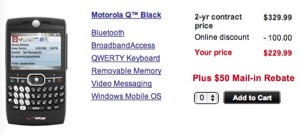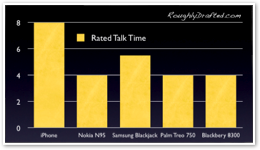


At WWDC, Apple revealed that outside developers could build custom iPhone web applications. But what about real iPhone apps, the kind that use the full power of the Cocoa frameworks and run on the bare metal of the iPhone itself, and not in a secured sandbox environment of the standards-based web?
What's Wrong With Writing Web Apps?
The Ajax web strategy for custom iPhone apps was bemoaned by more than a few observers as an “insult” to the developers who had been dreaming up all sorts of potential for iPhone games and applications. However, to developers specializing in Ajax applications, the news was welcomed.
In an article titled In defense of Ajax for the iPhone, Ryan Breen wrote, “The call for a ‘Real SDK’ is galling, and I think it reflects a prejudice against web applications and a lack of understanding of the progress achieved by the Ajax community in recent years.
“I believe that Ajax on the iPhone represents nothing less than the future of mobile development, and we’ll look back on Apple’s decision to forsake a ‘Real SDK’ as an articulation of a bold and correct vision that perfectly fits where the market is heading.”
A reader commenting on Breen's article noted, “I know of at least two highly paid, professional code writers that are furious that AJAX is the new SDK. They both are accustom to bidding hundreds of thousands of dollars for code work in C++, saying the project will take months, only to be underbid by someone who does it in a few hours for 1/100th of the price using AJAX and Ruby on Rails.
“Yes the future of development for not just the iPhone, but for all software is plain old AJAX with some form of off-line storage, Google Gears or whatever.” 

Of course, Google itself praised the iPhone's Ajax development platform, because Ajax is what Google uses to deliver nearly all of its applications, from Docs to Gmail to Reader.
Good for the Gander?
If web apps are such a good idea, why didn't Apple deliver its own apps via Ajax? The obvious answer is that Apple has access to the full power of the iPhone, enabling it to deliver an array of the most powerful and impressive apps ever demonstrated on an iPod-priced mobile device.
Of course, the other answer is that Apple is using Ajax to deliver applications. The first example was demonstrated in the WWDC keynote. It was just a simple company directory, but it demonstrated the ease of delivering native-looking client apps integrated with a company’s own servers as well as taking full advantage of the iPhone's dialing, maps, and document viewing features. 

Apple also has another application hiding out on its .Mac servers: a news reader. Visit reader.mac.com using a regular web browser and it will tell you “this application can only be viewed using the iPhone.”
So much for the worries that Safari on the iPhone doesn't have RSS features. And goodbye to the claim that Apple itself ‘wouldn't stoop to using Ajax’ to deliver powerful and useful iPhone apps.
After the reader.mac.com site got noticed, Apple took down the iPhone RSS photo and replaced it with the generic iPhone graphic with fish. What other web applications and extensions to .Mac has Apple got up its sleeves? We won’t know for another couple days.
Cuckoo for Cocoa Apps.
Quite obviously however, there are a lot of things that can't be done in Ajax. That is particularly true on the iPhone, which limits the web environment in certain ways to prevent applications from draining dead its relatively small battery. It appears that the Ajax environment won't be very good games, for example.
Having stated that, it should be pointed out that enterprising developers regularly impress with their ability to squeeze performance out of the most meager environments. Who would have thought that entertaining games could be delivered for the 5G iPod?
In any event, it really doesn't take too much imagination to think up all manner of potential applications for the iPhone. Is Apple really going to sit on that potential and leave it untapped? We don't have to speculate on the answers, because Apple executives have made it very clear that the company has big plans for the iPhone.
Back in April, Apple CFO Peter Oppenheimer announced details that made it clear that Apple had an ongoing plan for iPhone updates, even if that strategy was already obvious enough for me to be able to predict half a year earlier. Those plans are so significant that Apple decided to change how it would report its income.
Rather than counting the iPhone as an immediate sale, Apple announced plans for subscription accounting over a two year period. This is yet another game changing strategy that Apple is using to overturn and redefine the mobile industry.
The Mobile Phone Subsidy Shell Game.
A lot of bloggers reported that “the iPhone would not be subsidized.” I said it would be, and think it obviously is. Am I wrong? Consider Apple's plan and what it means to be subsidized. Today, most mobile phones sold in the US are subsidized with an immediate rebate that comes from the service provider.
For example, on Verizon's website, you get a $50 discount on a feature phone, or a $100 rebate on a smartphone, such as the Motorola Q. When I last checked, Verizon's webpage for my location only showed me the Black version of the Motorola Q, which costs $329.99, so after the $100 discount, the phone is $229.
 With another $50 mail-in rebate promotion, the price comes down to $180. That's quite a bit more than the last time I looked, but Verizon's mobile prices seem to fluctuate like the ticket prices of airplane seats.
With another $50 mail-in rebate promotion, the price comes down to $180. That's quite a bit more than the last time I looked, but Verizon's mobile prices seem to fluctuate like the ticket prices of airplane seats.While saving $100 and then another $50 sounds great, those savings are only part of a deal that requires a two year contract starting at $80/month. In other words, you have to promise to pay $1920 in order to get back $150 of the $330 retail price of the Motorola Q.
When plainly stated, this system of rebates sounds more like an absurd shell game. The reason for all the hand-waving is to distract users from the significant investment they are making, and instead focus on how cheap the Q appears to be. It’s a business plan revolves around treating the customer as if they were a moron.
Over the course of the two year contract of course, Verizon gets its $150 dollars back. If a user decides they want to change their phone or move or switch to another carrier, Verizon charges an early termination fee to recoup the costs it invested in snagging the customer with that subsidy rebate.
Why Apple Picked AT&T.
Verizon isn't alone; almost every mobile provider in the US does the same. That gave Apple little leverage for walking into the mobile industry and simply demanding a new set of rules.
Instead, Apple partnered with one provider. It apparently shopped around, as Verizon announced that it had turned Apple down.
Partnering with AT&T allowed Apple to use its new phone and its position in consumer electronics as leverage to demand that AT&T play along on a number of experimental new ways to sell mobiles.
-
•Apple got AT&T to change its back end servers to support visual voicemail.
-
•Apple got AT&T to offer simple rate plans that are priced competitively.
-
•Apple got AT&T to change how phones are provisioned, enabling Apple to manage more of the user experience.
-
•Apple got AT&T to change how mobiles are subsidized.
Instead of delivering the iPhone as a $750-900 phone like Nokia's N95, Sony's P990, or HTC's TyTN, and then artificially discounting it by hundreds of dollars when tied to an expensive service plan, Apple discounted the price of the iPhone up front.
Anyone who thinks that the iPhone can be sold at an iPod-like profit when it is only $150 more than the top end iPod hasn't given much thought to how much the iPhone's hardware actually costs. Getting numbers from iSuppli isn't going to help, because iSuppli is just guessing, and not doing a great job at it.
The Subsidy Trap.
The point of subsidizing anything is generally to shift around costs in order to incentivize specific buying patterns. The US heavily subsidizes agriculture with the intent to incentivize investments in farming. If it didn't, the country would simply import all of its food, because that would make more sense financially.
Apple isn't playing the mobile subsidy shell game, offering users a fake discount after they sign up for $1500 of phone service. Instead, it has set up its own subsidy plan, one that makes the iPhone more attractive, competitively priced, and gives the mobile industry a much needed kick in the pants.
The problem with Verizon's Q above is that after two years, the $150 discounts are but a faded memory and the user is now holding a phone that has done nothing but grow obsolete over the last two years. Verizon is now faced with signing the customer up with a new plan by offering another fake discount on a new phone.
How The iPhone Subsidy Works.
With the iPhone, Apple is offering its phone hardware as a low-profit item, compared to its other offerings. Buying an iPhone does not give Apple an immediate windfall of profit. Instead, it earns Apple a new customer.
Rather than leaving that customer with an iPhone that grows progressively more obsolete over two years and then trying to sell them a 2009 version as the existing mobile business model does, Apple is pursing an subscription model that will hook users on its phone, in a manner that works more like a Mac than a mobile.
Apple will release regular new updates and offer new software that users can download to customize and enhance their phone. Other phone platforms promise software upgrades and third party support, but simply have done very little to deliver that in a real way.
As I pointed out earlier, the iPhone delivers more than $454 worth of popular third party Windows Mobile software. It also delivers features Windows Mobile users can't buy at any price. But it will also offer additional software that will never make it to Windows Mobile, simply because there is no good reason to write it.
While it invests in the iPhone, Apple will also recoup service fees from AT&T through the life of the contract. That changes the game. Currently, hardware makers have no reason to upgrade their phones and software once they are sold, and they rarely do. When they do offer a firmware upgrade, it is often so difficult to perform that many users never do it, or even ever realize they can.
New iPhone Software.
New software and updates from Apple will continuously refine the iPhone and secure it from any vulnerabilities that crop up. Apple will also be able to address complaints that the iPhone doesn't support this or that feature.
We have good reason to believe Apple will deliver because it has on the Mac, the iPod, AirPort, Apple TV, QuickTime, etc. Microsoft has done a very poor job of upgrading its devices, especially Windows Mobiles. Instead, it prefers to sell a new version that often is not backwardly compatible with existing hardware.
Apple’s updates will draw a stark contrast between the iPhone as a handheld Mac, and the basic smartphones that can only run mini-apps and a few poorly drawn, overpriced software titles.
Apple has turned the mobile industry into a consumer facing market, where consumers will buy the phone, get updates, and buy software from Apple. That makes Apple responsible for their security, their demanded features, and their support. That’s not how things work today in the mobile world.
Selling to Consumers Rather than Providers.
Currently, the mobile industry has sold to the service providers. They are the ones paying out subsidies for the phones, so they have been dictating to hardware makers like Motorola what hardware features to support. The mobile providers don't really like WiFi and Bluetooth for example, so adoption has been slow.
Because Motorola sells to mobile providers rather than to consumers, it can't market phone features very effectively. It is also forced to make cheap phones that can appear to be free through the mobile providers' subsidy shell game illusion. That pressures Motorola to make cheap, low profit, featureless phones. Imagine Motorola's interest in upgrading them after the sale.
What about Microsoft? It licenses its Windows Mobile software to vendors like Motorola, who can only make cheap, featureless phones. Microsoft injects its own software, which similarly can't be too expensive or too functional because the hardware it runs on has to be cheap for the service providers. That means Microsoft similarly lacks any financial interest in updating Windows Mobile for users after the sale.
The Garbage Phone Market.
That has resulted in a wide array of poor phone hardware running minimalist software. Of course, there are mobile makers who market those fancy $750-900 phones, but they are relegated to obscure niches because there's such a wide gap between the free or nearly free phones and those expensive luxury ones.
Apple is nailing a position that fits a sweet spot between cheap and expensive, and is marketing it in its retail stores directly to consumers who already pay for hardware they find desirable.
Apple's phone is designed to be a long-life platform, not a disposable element designed primarily to distract from the outrageous cost of service. By leveraging the attractiveness of its hardware to bring service costs lower, Apple hopes to gain broad adoption for its phone just as consumers are demanding more functional devices.
Hook, Line, and Sinker.
For all the stink raised about Apple's vendor lock-in on iTunes, none of the wags seem to have stumbled onto the fact that the iPhone will be a far more effective trap.
Once users get accustomed to a full handheld computer that works intelligently, are they going to make any attempt to break free and grab a smartphone that really does very little, like the Motorola Q?
It will also be very difficult for other hardware makers to match Apple's product on an engineering scale. Sure, Nokia, Sony, and others can make fancier phones with features the iPhone lacks, whether its a 6 MP camera, a GPS unit, WiMax, an FM radio, or a cheese slicer, but the real trick to engineering is to know what to leave out.
Given that none of the major manufacturers have been able to deliver a competitive threat to the iPod, how much more stymied will they be in delivering an iPod with phone features, a touchscreen browser, and an extensible software platform, all at an attractive price? 

And if they are able to do so, how many desperate phone companies will jump at the chance of reinventing themselves by changing their server operations, their service plans, and their accounting systems just to accommodate that new phone?
A Hard Act To Follow.
Once Apple establishes the iPhone, it will have a position in mobiles that is difficult to copy. Hardware is easy to mock up, but its really hard to deliver software. Apple has been refining Mac OS X for a decade.
Microsoft has put a decade into WinCE, and it is now so obsolete that even Microsoft chose not to use it in the Xbox or its Origami handheld PCs, and is losing big money in its WinCE business.
Is Linux going to master the mobile before delivering a commercially viable desktop option? The majority of Linux based phones are being sold by Motorola to China, and are neither open nor part of a unified platform with the Linux offerings of other groups. Projects like OpenMoko will have zero leverage with mobile providers.
The Palm OS is an obsolete joke, and even the existing leader Symbian faces technology hurdles in moving its mobiles into the future.
Even Symbian leader Nokia decided to use Linux to power its web-based mobile tablets instead of its own Symbian, although it does not use Linux in its voice mobiles.
What Will Apple Do on the Application Front?
In Apple's April earnings report, Oppenheimer explained what the company had in mind for the future of the iPhone in regard to software development:
“We believe the iPhone is a revolutionary device that is years ahead of the competition. At Macworld, we demonstrated a number of the iPhone's breakthrough features, including its pioneering multi-touch display and user interface, visual voicemail, desktop class e-mail and web browsing, and of course, the best iPod ever.
“We plan to build on this incredible foundation by continuing to develop new software features as well as entirely new applications and incorporate them into the iPhone. Since iPhone customers will likely be our best advocates for the product, we want to get them many of these new features and applications at no additional charge as they become available.
“Since we will be periodically providing new software features to iPhone customers free of charge, we will use subscription accounting and recognize the revenue and product cost of goods sold associated with iPhone handset sales on a straight line basis over 24 months.
“So while the cash from iPhone sales will be collected at the time of sale, we will be recording deferred revenue and costs of goods sold on our balance sheet, and amortizing both of them into our earnings on a straight line basis over 24 months. We will continue to expense our iPhone engineering, sales and marketing costs as we incur them. This accounting policy will have no impact on cash flow or the economics of our business.”
Apple's Big Play.
Oppenheimer didn't leave a lot of grounds for ambiguity. Updates for the iPhone will be a major part of its attraction, and Apple will deliver them for free. The more software Apple puts on the iPhone, the more users will want it and want to retain it, and the more difficult it will be for competitors to copy it.
In this manner, Apple will be exploiting a secret to success that allowed Sun to take over the workstation business in the early 90s and Microsoft to take over cubicle business computing in the mid 90s. That well known secret will be hit on in a future article.
Come Say Hi While I Sit In Line.
I plan to go to the Union Square Apple Store and camp out for an iPhone. Not because I think it will be that difficult to get one, but because I stated in national news that I've never waited for a product, and that this could be my last chance to camp out before I get too old for that sort of thing to be exciting.
It would now be cheeky of me not to actually go do it.
I do have to admit that I'm feeling old enough already, and I still haven't had the stitches taken out from WWDC, where I managed to stab myself in the back rather severely with a broken mug by freakishly falling upon it.
So if you're in downtown SF, you can come say hi and perhaps bring me snacks. You can also help organize a flashmob rave Thursday night to help make the cold night sidewalk a little more fun.

Like reading RoughlyDrafted? Share articles with your friends, link from your blog, and subscribe to my podcast!
Did I miss any details?

Haloscan Q107
 Bookmark on Del.icio.us |
Bookmark on Del.icio.us |  Discuss on Reddit |
Discuss on Reddit |
 Critically review on NewsTrust
Critically review on NewsTrust
 Forward to Friends |
Forward to Friends | 
 Get RSS Feed |
Get RSS Feed |
 Download RSS Widget
Download RSS Widget
Check out the Daily Show Multi-Pass on iTunes.com

Next Articles:
Does Leopard Look Like Vista?
BHOze and the BHOzing BHOzers that BHOze Them.
EA’s Intel Mac Games: WINE and Cheese?
Previous Articles:
This Series
Apple's Secret iPhone Application Business Model
Thursday, June 28, 2007

Ad













